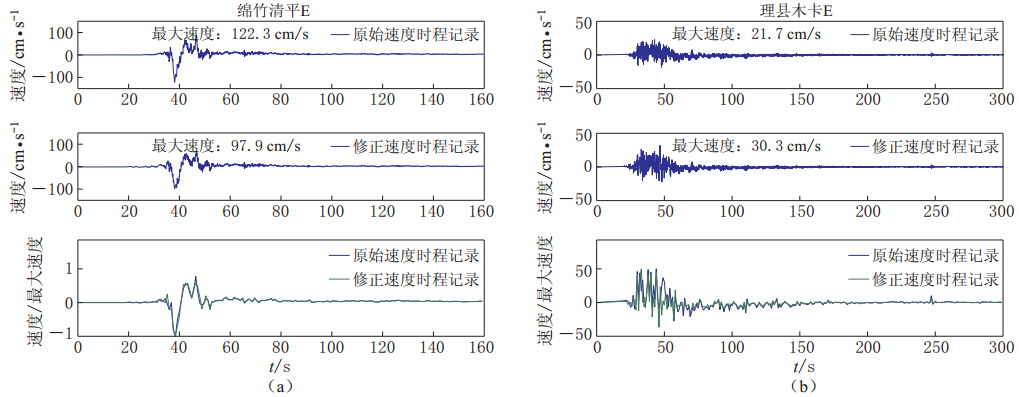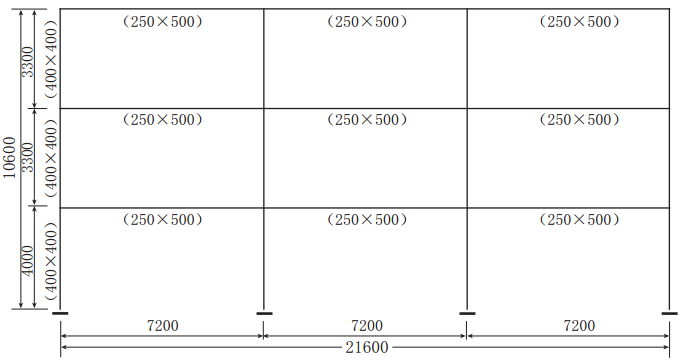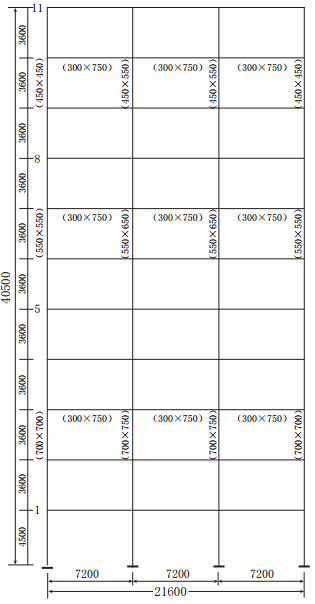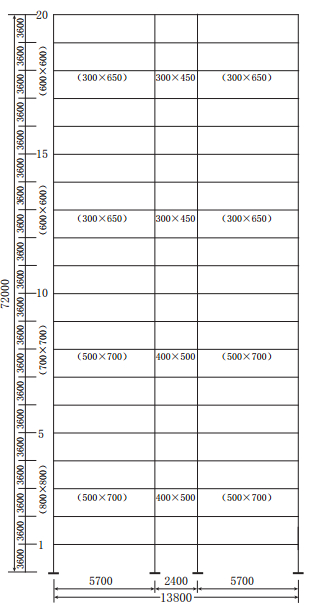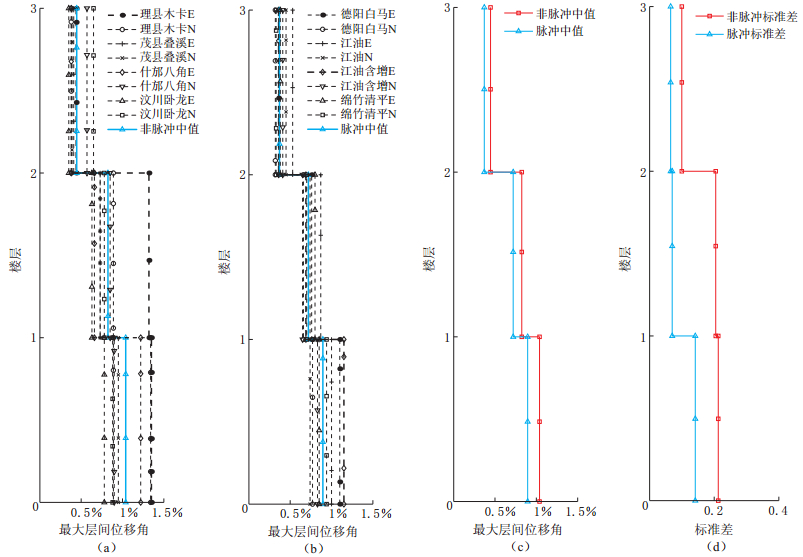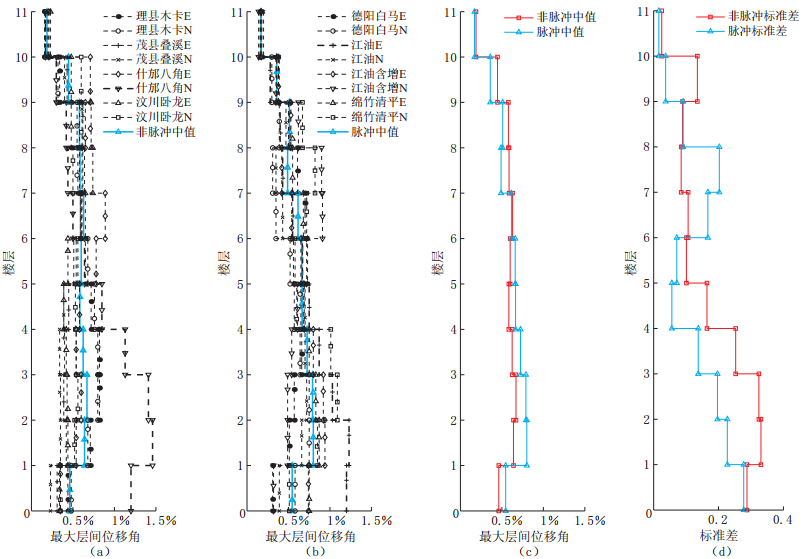Analysis of the seismic response characteristics of building structures subjected to near-fault ground motions from Wenchuan earthquake
-
摘要: 研究了具有不同自振特性的建筑结构在近断层速度脉冲型及非速度脉冲型地震动作用下的结构层间变形分布,揭示了近断层速度脉冲对工程结构地震响应的特殊影响. 从汶川MS8.0地震近断层强震记录中选取两组典型速度脉冲型记录和非脉冲型记录, 根据确定的目标地震动强度水平,利用时域叠加小波函数法对选择的强震记录进行调整, 使之与目标地震动水平对应的加速度反应谱保持一致, 以此作为结构地震反应分析的地震动输入. 选取具有不同自振特征的3层、11层和20层典型钢筋混凝土框架结构, 建立有限元分析模型, 分别计算在速度脉冲型与非速度脉冲型记录作用下这些结构层间变形分布. 研究表明,速度脉冲型记录与非速度脉冲型记录作用下结构层间变形有明显差异, 且与结构自振特征有关.就低层结构的层间变形而言, 非速度脉冲型记录的影响较速度脉冲型记录的影响大. 随着结构自振周期的增加, 高阶振型的影响更加明显. 与非速度脉冲型记录相比,速度脉冲型记录的结构层间位移反应中值及离散程度较大. 速度脉冲型记录更容易激发高层结构的高阶振型, 产生较大的层间位移反应. 非速度脉冲型记录对中低层结构层间变形影响较大.因此, 在开展近断层结构地震影响评价时, 应考虑近断层速度脉冲的影响.Abstract: This paper focuses on studying the effects of near-fault ground velocity pulses on building structures. Inter-story drift distributions of structures subjected to velocity pulse-type records and non-pulse-type records were investigated to reveal the effects of near-fault strong motions on building structures with different natural vibration periods. Two groups of typical velocity pulse records and non-pulse records were selected from Wenchuan MS8.0 earthquake, and a wavelet method of time domain synthesizing was used to modify the selected records, matching the target spectra from determined seismic intensity. The modified ground motions were used as the basic strong motion data for seismic response analysis. Finite models of 3, 11 and 20-story RC frame structures were established, and inter-story drift distributions of these three buildings subjected to typical velocity pulse-type records and non-pulse-type records were investigated. The study reveals that the inter-story drift distributions are quite different when the structures are subjected to pulse-type records and non-pulse-type records for the 3, 11 and 20-story RC frame structures, and are correlated with the natural vibration properties of building structures. In terms of low-rise buildings, inter-story drifts are larger for non-pulse-type records than those for pulse-type records. The influences of high modes on inter-story drifts become much more obvious with the increase of story number. The median value and dispersion of inter-story drifts are much larger when subjected to pulse-type records compared with non-pulse-type records for high-rise buildings. Pulse-type records tend to induce higher modes response, resulting in large inter-story drifts for high-rise buildings. Non-pulse-type records have relatively large effects on inter-story drifts primarily in the fundamental mode for low-rise buildings. It can be concluded that the effects of near-fault velocity pulses should be taken into consideration when assessing seismic damage potential for near-fault building structures.
-
Keywords:
- velocity pulses /
- near-fault /
- frame structure /
- inter-story drift
-
引言
近断层速度脉冲型强震记录的特征及其破坏作用引起了工程地震学和地震工程学界的关注. 速度脉冲记录对结构有特殊的破坏作用. Bertero等(1978)在研究1971年San Fernando强震记录时首次发现了幅值大、 周期长的速度脉冲型近断层强震记录及其破坏作用. 此后发生的一些大地震,如1979年Imperila Valley地震、 1992年Landers地震、 1994年Northridge地震、 1995年日本Kobe地震等,都观测到了这种近断层速度脉冲型记录. 已有的研究表明,有些结构大的结构层间位移常与这种长周期速度脉冲型记录密切相关,可能是由幅值大、 周期长的速度脉冲型记录造成的 (Iwan,Chen,1994; Somerville,1995; Iwan,1997; Malhotra,1999; MacRac et al,2000). 此外,这种速度脉冲型记录的形成与断层破裂的方向性效应和断层逆冲运动所造成的永久位移密切相关(Somerville et al,1997; Huang et al,2000; Chen et al,2001; 李爽,谢礼立,2006; 杨迪雄等,2009; 杨迪雄,赵岩,2010).
中国数字强震动观测台网在2008年汶川MS8.0地震时获取到了大量的近场强震加速度记录(Li et al,2008, 2010; 于海英等,2008),发现有些近断层强震记录具有明显的速度脉冲型特征(Wen et al,2010; Lu et al,2010; 谢俊举等,2011),为开展近断层速度脉冲型记录的工程特性研究提供了宝贵的资料. 本文从汶川地震近断层强震记录中选取了速度脉冲型与非速度脉冲型两组典型地震动记录,采用时域叠加小波函数法对所选择的强震记录进行调整,使其加速度反应谱与目标地震动水平保持一致,建立不同自振特性的钢筋混凝土框架结构有限元模型,分析在不同类型强震记录作用下结构层间变形分布特征,试图揭示汶川地震近断层速度脉冲对工程结构地震响应的影响.
1. 脉冲记录的选取与调整
为分析汶川地震近断层脉冲型地震动对工程结构的特殊破坏作用,本文从汶川地震中选取两组典型速度脉冲记录和非速度脉冲记录,对比分析这两组典型记录对结构影响的不同特点. 参考Baker(2007)提出的近断层地震动脉冲的分析方法,从汶川地震获取的64组近断层记录中选取8条典型速度脉冲型加速度记录和8条非速度脉冲型加速度记录,作为地震动输入. 选取的典型速度脉冲型记录和非速度脉冲型记录的主要参数如表1和表2所示.
表 1 选取的近断层速度脉冲型记录的主要参数Table 1. Parameters of selected near-fault pulse-type ground motions from Wenchuan earthquake 表 2 选取的近断层非速度脉冲型记录的主要参数Table 2. Parameters of selected non-pulse-type ground motions from Wenchuan earthquake
表 2 选取的近断层非速度脉冲型记录的主要参数Table 2. Parameters of selected non-pulse-type ground motions from Wenchuan earthquake
图1分别给出这两组阻尼比为5%的加速度反应谱(注:本文中加速度反应谱用“g”表示,1g=9.8 m/s2). 可以看出,速度脉冲型记录与非速度脉冲型记录的加速度反应谱值及谱形有较大的不同. 如果直接以此作为结构地震反应分析的地震动输入,则很难确认引起结构地震反应差异较大的影响因素,即究竟归因于反应谱谱值或谱形,还是速度脉冲. 为了能揭示速度脉冲型记录特殊的工程特性,需要对选取的两组记录进行调整,使其加速度反应谱一致或彼此接近(Alavi,Krawinkler,2004; 赵凤新等,2008),以消除加速度反应谱因素的影响. 同时,调整后的地震动需保持原始地震动的脉冲特征.
![]() 图 1 GB50011-2001设计反应谱(目标谱)和原始强震记录加速度反应谱(a) 原始非速度脉冲型记录加速度反应谱; (b) 原始速度脉冲型记录加速度反应谱;(c) 原始记录的平均加速度反应谱Figure 1. GB50011-2001 design spectrum (target spectrum) and acceleration response spectrum of original ground motions(a) Original non-pulse-type acceleration response spectrum; (b) Original pulse-type acceleration response spectrum; (c) Mean response spectrum of scaled ground motions
图 1 GB50011-2001设计反应谱(目标谱)和原始强震记录加速度反应谱(a) 原始非速度脉冲型记录加速度反应谱; (b) 原始速度脉冲型记录加速度反应谱;(c) 原始记录的平均加速度反应谱Figure 1. GB50011-2001 design spectrum (target spectrum) and acceleration response spectrum of original ground motions(a) Original non-pulse-type acceleration response spectrum; (b) Original pulse-type acceleration response spectrum; (c) Mean response spectrum of scaled ground motions常用的强震记录调整法有幅值缩放法和谱值匹配法(Kalkan,Luco,2011). 与幅值缩放法相比,谱值匹配法的精度更高,并在一定程度上保留原始地震动的非平稳特征. 时域叠加小波函数法(Mukherjee,Gupta,2002; Suarez,Montejo,2005; Hancock et al,2006)对原始记录修改最小,保持了原始记录的自然积分关系,并且调整后基本不需重新进行基线校正(全伟,李宏男,2008),因此本文采用时域叠加小波函数法对所选定的两组强震记录进行调整. 图2分别以近断层脉冲型地震动绵竹清平E和非脉冲型地震动理县木卡E为例,比较了按照目标加速度反应谱修正前后地震动的速度时程. 可以看出,修正前后地震动速度时程波形相差不大,速度脉冲型加速度时程保持了原地震记录的脉冲特征.
本文以建筑抗震设计规范规定的罕遇地震下设计基本地震加速度0.30g,设计地震动分组第二组(水平地震影响系数0.90,特征周期0.40 s,阻尼比5%)对应的设计反应谱作为目标谱. 考虑结构可能出现高阶振型的影响以及结构进入非线性阶段后振动周期延长等,修正后的地震反应谱应在一定周期段内(0.2T1—1.5T1,本文选取T1为分析模型中20层钢筋混凝土结构的基本周期)与目标谱接近(Kalkan,Kunnath,2006; American Society of Civil Engineers,2006). 采用时域叠加小波函数法对原始脉冲与非脉冲两组记录进行修正,得到的每组地震动的加速度反应谱如图3所示. 从图中可以看出,调整后的地震动加速度反应谱在低周期段(0—0.4 s)有一定差别,但在结构敏感周期段内(0.4—3 s),调整后的地震动加速度反应谱与目标谱有很好的匹配. 与幅值缩放法相比,时域叠加小波函数法对地震动的频率和幅值都根据目标谱做了相应调整,使得调整后的地震动能够在工程关注的周期段内与目标谱保持高度的一致,且基本保持原始地震记录的脉冲特征,可有利于最大程度减少加速度反应谱的不同对结构反应的影响.
![]() 图 3 GB50011-2001设计反应谱(目标谱)和调整后强震记录加速度反应谱(a) 调整后非速度脉冲型记录加速度反应谱; (b) 调整后速度脉冲型记录加速度反应谱; (c)调整后记录的平均加速度反应谱Figure 3. GB50011-2001 design spectrum (target spectrum) and modified acceleration response spectrum of ground motions (a) Modified non-pulse-type ground motions; (b) Modified pulse-type ground motions; (c) Mean response spectrum of scaled ground motions
图 3 GB50011-2001设计反应谱(目标谱)和调整后强震记录加速度反应谱(a) 调整后非速度脉冲型记录加速度反应谱; (b) 调整后速度脉冲型记录加速度反应谱; (c)调整后记录的平均加速度反应谱Figure 3. GB50011-2001 design spectrum (target spectrum) and modified acceleration response spectrum of ground motions (a) Modified non-pulse-type ground motions; (b) Modified pulse-type ground motions; (c) Mean response spectrum of scaled ground motions2. 建筑结构模型
选取具有不同自振周期的典型钢筋混凝土框架结构,研究速度脉冲对建筑结构地震反应的影响特点. 采用结构非线性地震反应分析程序IDARC (Reinhorn et al,2006),分别建立3层、 11层和20层的典型钢筋混凝土框架结构地震反应分析模型. 模型结构的载荷、 平面布置和层高均参考实际办公楼的结构设计,按照国家质量监督检验检疫总局,中华人民共和国建设部(2001)《建筑结构抗震设计规范》进行抗震设计,设防烈度8度,设计基本加速度0.2g,设计地震第二组,场地类别为Ⅱ类. 3层、 11层和20层钢筋混凝土框架的基本周期分别为0.58,1.43和1.99 s. 考虑P-Δ效应,楼板平面采用刚性假定,钢筋混凝土构建的恢复力模型采用三线型骨架模型.
2.1 模型一
3层钢筋混凝土框架结构的立面图如图4所示. 框架平面为7.2 m×7.2 m柱网,底层层高4 m,其它层高均为3.3 m,总高度为10.6 m,梁尺寸统一使用250 mm×500 mm,柱尺寸统一使用400 mm×400 mm; 梁柱的混凝土均采用C30,二者纵筋统一使用HRB335,箍筋统一使用HPB235; 梁配筋率为1.5%,柱配筋率为2%.
2.2 模型二
11层钢筋混凝土框架结构的立面图如图5所示. 框架底层层高4.5 m,其它层高均为3.6 m,总高度为40.5 m,梁尺寸统一使用300 mm×750 mm. 柱尺寸为: 1—5层,边柱700 mm×700 mm,中柱700 mm×750mm; 6—8层,边柱550 mm×550mm,中柱550 mm×650mm; 9—11层,边柱450 mm×450 mm,中柱450 mm×550 mm. 梁和柱的混凝土分别采用C30和C40,二者纵筋统一使用HRB335,箍筋统一使用HPB235; 梁配筋率为1.5%,柱配筋率为2%.
2.3 模型三
2 0层钢筋混凝土框架结构的立面图如图6所示. 框架层高均为3.6 m,总高度为72 m. 梁尺寸为: 1—5层,边梁500 mm×700 mm,中梁500 mm×500 mm; 6—10层,边梁500 mm ×700 mm,中梁400 mm×500 mm; 11—20层,边梁300 mm×650 mm,中梁300 mm×450 mm. 柱尺寸为: 1—5层,800 mm×800 mm; 6—10层,700 mm×700 mm; 11—20层,600 mm×600 mm. 梁选用的混凝土为: 1—5层为C35,6—15层为C30,16—20层为C25; 柱的混凝土采用: 1—5层为C40,6—15层为C35,16—20层为C30. 梁和柱的纵筋统一使用HRB335,箍筋统一使用HPB235. 梁柱配筋为梁配筋率1.5%,柱配筋率2%.
3. 脉冲与非脉冲对结构层间位移反应的影响
以调整后的两组加速度时程作为地震动输入,利用IDARC进行结构动力反应分析. 选取层间位移角作为结构反应参数,考察速度脉冲对具有不同自振周期的建筑结构地震反应影响的特点. 图7,8,9分别给出了在近断层脉冲与非脉冲地震动作用下3层、 11层和20层钢筋混凝土框架结构楼层最大层间位移角. 可以看出,在速度脉冲型记录和非速度脉冲型记录作用下3层、 11层和20层框架结构最大层间位移角的分布形式有明显不同.
![]() 图 7 调整后地震动作用下3层结构最大层间位移角(a) 非速度脉冲型地震动; (b) 速度脉冲型地震动; (c) 中值比较; (d) 标准差比较Figure 7. Maximum inter-story drift for a 3-story building subjected to modified ground motions (a) Non-pulse-type ground motions; (b) Pulse-type ground motions; (c) Comparison between median values; (d) Dispersion comparison of maximum inter-story drift ratio (IDR)
图 7 调整后地震动作用下3层结构最大层间位移角(a) 非速度脉冲型地震动; (b) 速度脉冲型地震动; (c) 中值比较; (d) 标准差比较Figure 7. Maximum inter-story drift for a 3-story building subjected to modified ground motions (a) Non-pulse-type ground motions; (b) Pulse-type ground motions; (c) Comparison between median values; (d) Dispersion comparison of maximum inter-story drift ratio (IDR)![]() 图 8 调整后地震动作用下11层结构最大层间位移角(a) 非速度脉冲型地震动; (b) 速度脉冲型地震动; (c) 中值比较; (d) 标准差比较Figure 8. Maximum inter-story drift for an 11-story building subjected to modified ground motions(a) Non-pulse-type ground motions; (b) Pulse-type ground motions; (c) Comparison between median values; (d) Dispersion comparison
图 8 调整后地震动作用下11层结构最大层间位移角(a) 非速度脉冲型地震动; (b) 速度脉冲型地震动; (c) 中值比较; (d) 标准差比较Figure 8. Maximum inter-story drift for an 11-story building subjected to modified ground motions(a) Non-pulse-type ground motions; (b) Pulse-type ground motions; (c) Comparison between median values; (d) Dispersion comparison![]() 图 9 调整后地震动作用下20层结构最大层间位移角(a) 非速度脉冲型地震动; (b) 速度脉冲地震动; (c) 中值比较; (d) 标准差比较Figure 9. Maximum inter-story drift for a 20-story building subjected to modified ground motions (a) Non-pulse-type ground motions; (b) Pulse-type ground motions; (c) Comparison between median values; (d) Dispersion comparison of IDR
图 9 调整后地震动作用下20层结构最大层间位移角(a) 非速度脉冲型地震动; (b) 速度脉冲地震动; (c) 中值比较; (d) 标准差比较Figure 9. Maximum inter-story drift for a 20-story building subjected to modified ground motions (a) Non-pulse-type ground motions; (b) Pulse-type ground motions; (c) Comparison between median values; (d) Dispersion comparison of IDR对于3层框架(图7),最大层间位移角出现在底层,是由调整后的非脉冲型记录理县木卡E引起的,最大值为1.35%(图7a); 在速度脉冲型记录中,最大反应是由调整后的记录江油含增E引起,为1.15%(图7b). 非脉冲型记录比脉冲型记录作用下的结构最大层间位移角中值要大近8%,非速度脉冲型记录的结构最大层间位移角离散性较速度脉冲型记录的大,其最大的标准差是脉冲型记录下标准差的2.9倍.
对于11层结构(图8),最大反应并没有出现在底层,而是出现在中部. 非速度脉冲型组中什邡八角N引起的层间位移角最大,发生在第二层,其值为1.46%(图8a); 而对于速度脉冲型组,最大反应是由江油E引起的,其值为1.23%(图8b). 在7层以下,速度脉冲型地震作用下的层间位移角中值比非速度脉冲型地震动的大,底层的层间位移反应相差最大,接近50%; 在8—11层,非速度脉冲型地震动作用下的层间位移角中值大于速度脉冲型地震动的层间位移角中值,第8层相差最大,接近21%. 对于结构反应的离散性,在1—6层,非速度脉冲型的要大于速度脉冲型的; 在7—9层,结构反应的离散性发生转换,速度脉冲型要大于非速度脉冲型; 而在10层和11层,结构反应的离散性发生转换,非速度脉冲型再次大于速度脉冲型.
对于20层结构(图9),速度脉冲型地震动作用下结构反应整体上要稍大于非脉冲型地震动. 最大层间反应主要分布在中上部和中下部. 其中,中上部最大层间位移角是由速度脉冲型组中绵竹清平E引起,发生在第14层,为1.18%; 中下部最大层间位移角在第6层,其值为1.05%(图9b). 非速度脉冲型组中最大层间位移角是由理县木卡N引起,发生在第14层,其值为1.11%(图9a). 对于结构反应的离散性,速度脉冲型的亦要整体大于非速度脉冲型的.
比较图7a,b、 图8a,b和图9a,b给出的3种结构模型反应结果可以发现,无论是速度脉冲型地震动还是非脉冲型地震动,对于同一结构,最大层间位移角随楼层的分布表现出近乎一致的特征. 低层结构(3层框架)呈阶梯分布,底部反应最大,顶部最小; 中高层(11层框架)呈倒“D”型分布,中部反应大,两端反应稍小; 而对于高层(20层框架)则呈“B”型分布,中上部和中下部反应较大,低层和顶层反应较小. 分析可知,这种分布特征可能与结构在地震动作用下各阶振型的参与权重有关. 对于低层结构,结构层间位移反应主要由第一振型控制; 而随着层数的增大,高阶振型影响愈加明显. 此外,还发现在同组记录中,往往有一至两条记录对结构的影响差别较大. 例如,非脉冲组地震动理县木卡E对3层结构,什邡八角N对11层结构和脉冲组地震动江油E对11层结构的反应表现出与同组其它地震动不一样的分布特征. 这可能与地震动有一定的随机性,以及调整后的反应谱在低周期段仍有差异有关.
对比调整后速度脉冲型与非速度脉冲型两组地震动输入作用下3层、 11层和20层框架结构各层的最大层间位移角的中值分布变化情况,二者作用下结构的反应有一定差异,且随着结构模型层数的不同,总体上表现出一定的规律. 速度脉冲型与非速度脉冲型记录对低层结构的层间位移反应影响的差别较小. 而随着结构层数的增高,速度脉冲型的记录对结构层间位移响应的影响由小于非速度脉冲型,逐渐发展到整体大于非速度脉冲型. 速度脉冲型作用下20层框架结构的层间位移变形,要比非速度脉冲型记录作用下大,接近30%. 对于结构反应的离散性,亦表现出如此规律,速度脉冲型作用下的低层结构反应的离散性比非速度脉冲型记录的小. 而随着结构层数的增高,速度脉冲型作用下的结构反应的离散性逐渐增大,其中20层框架,速度脉冲型作用下的结构层间位移变形的标准差要比非速度脉冲型记录的大10%以上. 即速度脉冲型相比非速度脉冲型地震动更容易激发高层结构的层间位移响应,对高层结构的作用更加明显.
4. 讨论与结论
本文从汶川地震近断层强震记录中分别选取8条典型速度脉冲型和8条非速度脉冲型记录,作为结构反应的地震动输入. 基于有限单元方法分别建立了3层、 11层和20层的典型钢筋混凝土框架结构模型,研究钢筋混凝土框架在近断层速度脉冲型与非速度脉冲型作用下的结构层间位移变形特点,揭示汶川地震近断层速度脉冲对结构地震反应的影响. 主要结论如下:
1) 在两组地震动加速度反应谱一致的前提下,与非速度脉冲记录相比,速度脉冲记录对低层结构的层间位移反应影响的差别较小. 而随着结构层数的增高,速度脉冲记录对结构层间位移响应的影响逐渐明显. 结构层间位移变形的离散性也表现出类似规律. 非速度脉冲地震动对受第一振型控制的中低层结构层间变形影响较大; 速度脉冲型记录则更容易激发高层结构的高阶振型的响应,产生较大的变形.
2) 与集集地震和北岭地震(赵凤新等,2008; 杨迪雄等,2009)近断层速度脉冲型地震动引起高层结构较大弹塑性变形相比,汶川近断层多层和高层结构的地震反应较小. 这可能与汶川地震速度脉冲型地震动长周期效应较弱(Li et al,2010; Wen et al,2010)有关.
3) 由于地震动的复杂性和随机性,反应谱并不能完全反映地震动的工程特性,结构的弹塑性反应会因地震动有无速度脉冲而表现不同. 在结构抗震设计和评估中,特别是对于高层结构,在考虑地震动反应谱特征的同时,应充分考虑速度脉冲型地震动对结构抗震安全的影响; 条件允许的情况下,应选择多个地震事件的速度脉冲记录.
中国强震动观测台网为本研究提供了强震记录数据; 审稿人为本文的完善提出了许多宝贵的意见. 作者在此一并表示感谢.
-
图 1 GB50011-2001设计反应谱(目标谱)和原始强震记录加速度反应谱(a) 原始非速度脉冲型记录加速度反应谱; (b) 原始速度脉冲型记录加速度反应谱;(c) 原始记录的平均加速度反应谱
Figure 1. GB50011-2001 design spectrum (target spectrum) and acceleration response spectrum of original ground motions(a) Original non-pulse-type acceleration response spectrum; (b) Original pulse-type acceleration response spectrum; (c) Mean response spectrum of scaled ground motions
图 3 GB50011-2001设计反应谱(目标谱)和调整后强震记录加速度反应谱(a) 调整后非速度脉冲型记录加速度反应谱; (b) 调整后速度脉冲型记录加速度反应谱; (c)调整后记录的平均加速度反应谱
Figure 3. GB50011-2001 design spectrum (target spectrum) and modified acceleration response spectrum of ground motions (a) Modified non-pulse-type ground motions; (b) Modified pulse-type ground motions; (c) Mean response spectrum of scaled ground motions
图 7 调整后地震动作用下3层结构最大层间位移角(a) 非速度脉冲型地震动; (b) 速度脉冲型地震动; (c) 中值比较; (d) 标准差比较
Figure 7. Maximum inter-story drift for a 3-story building subjected to modified ground motions (a) Non-pulse-type ground motions; (b) Pulse-type ground motions; (c) Comparison between median values; (d) Dispersion comparison of maximum inter-story drift ratio (IDR)
图 8 调整后地震动作用下11层结构最大层间位移角(a) 非速度脉冲型地震动; (b) 速度脉冲型地震动; (c) 中值比较; (d) 标准差比较
Figure 8. Maximum inter-story drift for an 11-story building subjected to modified ground motions(a) Non-pulse-type ground motions; (b) Pulse-type ground motions; (c) Comparison between median values; (d) Dispersion comparison
图 9 调整后地震动作用下20层结构最大层间位移角(a) 非速度脉冲型地震动; (b) 速度脉冲地震动; (c) 中值比较; (d) 标准差比较
Figure 9. Maximum inter-story drift for a 20-story building subjected to modified ground motions (a) Non-pulse-type ground motions; (b) Pulse-type ground motions; (c) Comparison between median values; (d) Dispersion comparison of IDR
表 1 选取的近断层速度脉冲型记录的主要参数
Table 1 Parameters of selected near-fault pulse-type ground motions from Wenchuan earthquake

表 2 选取的近断层非速度脉冲型记录的主要参数
Table 2 Parameters of selected non-pulse-type ground motions from Wenchuan earthquake

-
李爽, 谢礼立. 2006. 近场脉冲型地震动对钢筋混凝土框架结构影响[J]. 沈阳建筑大学学报, 22(3): 406-410. 国家质量监督检验检疫总局, 中华人民共和国建设部. 2001. GB50011-2001建筑抗震设计规范[S]. 北京: 中国建筑工业出版社: 44-56. 全伟, 李宏男. 2008. 调整已有地震动拟和规范反应谱人造地震动方法比较[J]. 防灾减灾工程学报, 28(1): 91-97. 谢俊举, 温增平, 高孟潭, 袁美巧, 何少林. 2011. 2008年汶川地震近断层地震动的非平稳特征[J]. 地球物理学报, 54(3): 728-736. 杨迪雄, 潘建伟, 李刚. 2009. 近断层脉冲型地震动作用下建筑结构的层间变形分布特征和机理分析[J]. 建筑结构学报, 30(4): 108-118. 杨迪雄, 赵岩. 2010. 近断层地震动破裂向前方向性与滑冲效应对隔振建筑结构抗震性能的影响[J]. 地震学报, 32(5): 579-587. 于海英, 王栋, 杨永强, 卢大伟, 解全才, 张明宇, 周宝峰, 江纹乡, 程翔, 杨剑. 2008. 汶川8.0级地震强震动特征初步分析[J]. 震灾防御技术, 3(4): 321-336. 赵凤新, 韦韬, 张郁山. 2008. 近断层速度脉冲对钢筋混凝土框架结构地震反应的影响[J]. 工程力学, 25(10): 180-187. Alavi B, Krawinkler H. 2004. Behavior of moment resisting frame structures subjected to near-fault ground motions[J]. Earthq Eng Struct Dyn, 33(6): 687-706.
American Society of Civil Engineers. 2006. Minimum Design Loads for Buildings and Other Structures. ASCE 7-05 [S]. Reston, Virginia, United States: American Society of Civil Engineers: 175-176.
Baker J K. 2007. Quantitative classification of near-fault ground motion using wavelet analysis[J]. Bull Seism Soc Amer, 97(5): 1486-1501.
Bertero V V, Mahin S A, Hrrera R A. 1978. Aseismic design implications of near-fault San Fernando earthquake records[J]. Earthq Eng Struc Dyn, 6(1): 31-42.
Chen K C, Huang B S, Wang J H, Huang W G, Chang T M, Hwang R D, Chiu H C, Peter Tsai C C. 2001. An observation of rupture pulses of the 20 September 1999 Chi-Chi, Taiwan, earthquake from near-field seismograms[J]. Bull Seism Soc Amer, 91(5): 1247-1254.
Hancock J, Watson-L J, Abrahamson N A, Bommer J J, Markatis A, Mccoy E, Mendis R. 2006. An improved method of matching response spectra of recorded earthquake ground motion using wavelets[J]. J Earthq Eng, 10(1): 67-89.
Huang B S, Chen K C, Wang J H, Huang W G, Wang J H, Chang T M, Hwang R D, Chiu H C, Peter Tsai C C. 2000. Characteristics of strong ground motion across a thrust fault tip from the September 21, 1999, Chi-Chi, Taiwan earthquake[J]. Geophys Res Lett, 27: 2729-2732.
Iwan W D, Chen X. 1994. Important near-field ground motion data from the Landers earthquake[C]//Proceedings of the 10th European Conference on Earthquake Engineering. Vienna: 229-234.
Iwan W D. 1997. Drift spectrum: Measure of demand for earthquake ground motions[J]. J Struct Eng, 123(4): 397-404.
Kalkan E, Kunnath S K. 2006. Effects of fling step and forward directivity on seismic response of buildings[J]. Earthquake Spectra, 22(2): 367-390.
Kalkan E, Luco N. 2011. Special issue on earthquake ground-motion selection and modification for nonlinear dynamic analysis of structures[J]. J Struct Eng, 137(3): 277, doi:10.10611(ASCE)ST.1943-541X.0000355.
Li X J, Zhou Z H, Huang M, Wen R Z, Yu H Y, Lu D W, Zhou Y N, Cui J W. 2008. Preliminary analysis of strong-motion recordings from the magnitude 8.0 Wenchuan, China, earthquake of May 12[J]. Seism Res Lett, 79(6): 844-854.
Li X J, Liu L, Wang Y S, Yu T. 2010. Analysis of horizontal strong-motion attenuation in the great 2008 Wenchuan earthquake[J]. Bull Seism Soc Amer, 100(5B): 2440-2449.
Lu M, Li X J, An X W, Zhao J X. 2010. A preliminary study on the near-source strong-motion characteristics of the great 2008 Wenchuan earthquake[J]. Bull Seism Soc Amer, 100(5B): 2491-2507.
MacRac G A, Morrow D V, Roder C W. 2000. Near-fault ground motion effects on simple structures[J]. J Struct Eng, 127(9): 996-1004.
Malhotra P K. 1999. Response of buildings to near field pulse-like ground motions[J]. Earthq Eng Struct Dyn, 28(11): 1309-1326.
Mukherjee S, Gupta V K. 2002. Wavelet-based generation of spectrum-compatible time-histories[J]. Soil Dyn Earthq Eng, 22(9-12): 799-804.
Reinhorn A M, Kunnath C K, Valles R E, Li C, Madan A. 2006. IDARC2D Version 6.1: A Program for the Inelastic Damage Analysis of Buildings[M]. Buffalo, New York: State University of New York: 1-62.
Somerville P. 1995. Characterization of Ground Motion at the Sites of Subjected Buildings[R]. SAC Joint Venture Rep, SAC 95-03.
Somerville P G, Smith N F, Graves R W, Abrahamson N A. 1997. Modification of empirical strong ground motion attenuation relations to include the amplitude and duration effects of rupture directivity[J]. Seism Res Lett, 68(1): 199-222.
Suarez L E, Montejo L A. 2005. Generation of artificial earthquakes via the wavelet transform[J]. Int J Solids Struct, 42(5): 5905-59l9.
Wen Z P, Xie J J, Gao M T, Hu Y X, Chau K T. 2010. Near-source ground motion characteristics of the MS8.0 Wenchuan earthquake[J]. Bull Seism Soc Amer, 100(5B): 2425-2439.
-
期刊类型引用(7)
1. 赵天次,赵伯明. 基于小波分析的近断层地震动最强速度脉冲识别方法与应用. 振动与冲击. 2021(08): 41-49 .  百度学术
百度学术
2. 赵晓芬,温增平,陈波,刘奕君. 适用于全周期结构的速度脉冲型地震动强度表征参数研究. 地震学报. 2019(04): 536-547 .  本站查看
本站查看
3. 赵晓芬,温增平,陈波. 近断层地震动最强速度脉冲方向分量特性研究. 地震学报. 2018(05): 673-688+690 .  本站查看
本站查看
4. 陈秋旺. 近断层地震下大底盘框架结构非线性响应分析及减震控制. 福建建设科技. 2018(06): 1-5 .  百度学术
百度学术
5. 李敏,黄天璨. 近断层地震动作用下超高层结构地震响应分析. 华南地震. 2018(04): 84-89 .  百度学术
百度学术
6. 杜永峰,宋翔,包超,朱翔,谈志鸿. 近场地震作用下RC框架鲁棒性分析. 振动与冲击. 2016(03): 192-197 .  百度学术
百度学术
7. 张常勇,钟铁毅,李徐,杨海洋. FPS隔震简支梁桥近断层地震响应研究. 世界桥梁. 2014(05): 48-53 .  百度学术
百度学术
其他类型引用(12)




 下载:
下载:

